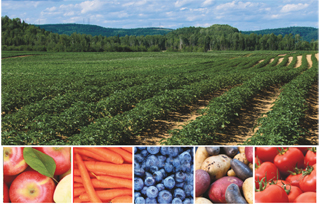The world’s second largest country by total area, Canada spans more than 3.8 million square miles (9.98 million kilometers) of land and water. Its ten provinces and three territories are home to widely varying landscapes, many of which contribute to a prosperous produce industry.
The vast majority of Canada’s fruits and vegetables are grown in eight of the country’s provinces: Alberta, British Columbia, Manitoba, Nova Scotia, New Brunswick, Ontario, Quebec, and Prince Edward Island. We take a look at these provinces, the challenges their growers faced (from rain and hail to frost and pest outbreaks), and the resulting fluctuations of top crops grown within their borders.
Alberta
Home to an estimated 4 million people, Alberta is the most populous of Canada’s three Prairie provinces. The third largest food and beverage producing province, Alberta represents almost 20 percent (to the tune of nearly $9 billion annually) of Canada’s total agri-food exports.
In addition to being known as the “Sunshine Province,” Alberta is a major potato producer and its farmers grow 197 different varieties. The vast majority (approximately 85 percent) are for processing, ultimately used for French Fries and potato chips. About 10 percent are for seed and only 5 percent are for the fresh market.
Alberta ranks third in the country behind Prince Edward Island (PEI) and Manitoba in harvested acreage. Yields, however, are a different story: Alberta averages the highest annual yields of the provinces at over 361 hundredweight (cwt) per acre in 2014, with Manitoba close behind and PEI ranked fifth. The total annual value of the province’s potato industry is approximately $1 billion from 51,742 harvested acres.
Terence Hochstein, executive director with the Potato Growers of Alberta, says the 2013-14 season was an average year as far as production. “It was a long harvest because of wet weather,” he explains.
In fact, Hochstein says variable weather was the greatest challenge for Alberta potato growers in 2014. “We’re predominantly irrigation in Southern Alberta where process potatoes are grown, but Mother Nature did not cooperate,” he remarks. “Weather was our biggest issue all year long: we had an early frost, we had some snow, and we had lots of rain in the fall before we started our harvest.”
In both 2013 and 2014, Alberta potato growers also contended with late blight, the potato disease responsible for the devastating Irish Potato Famine back in the 1800s. Though Alberta’s late blight was contained and not widespread, there can be significant yield and quality losses during an outbreak.



